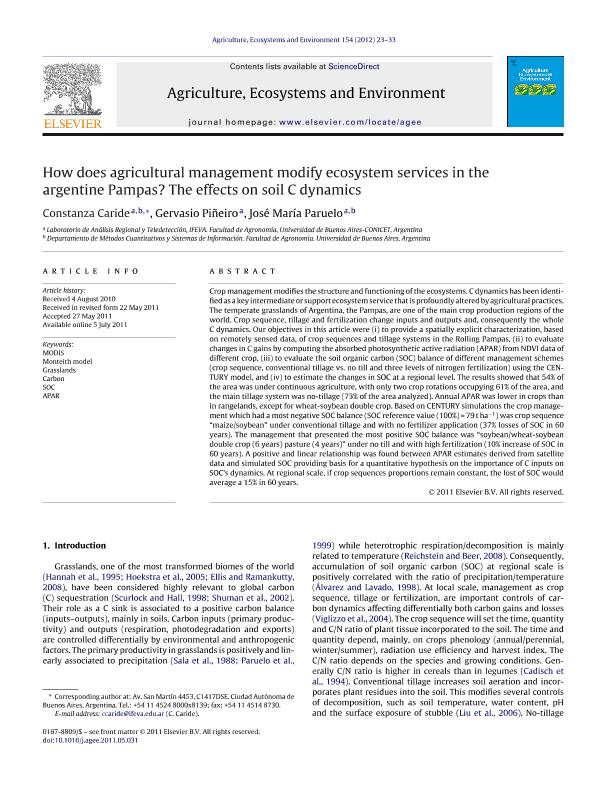Mostrar el registro sencillo del ítem
dc.contributor.author
Caride, Constanza

dc.contributor.author
Piñeiro, Gervasio

dc.contributor.author
Paruelo, José

dc.date.available
2018-09-24T14:12:08Z
dc.date.issued
2012-07
dc.identifier.citation
Caride, Constanza; Piñeiro, Gervasio; Paruelo, José; How does agricultural management modify ecosystem services in the argentine Pampas? The effects on soil C dynamics; Elsevier Science; Agriculture, Ecosystems and Environment; 154; 7-2012; 23-33
dc.identifier.issn
0167-8809
dc.identifier.uri
http://hdl.handle.net/11336/60714
dc.description.abstract
Crop management modifies the structure and functioning of the ecosystems. C dynamics has been identified as a key intermediate or support ecosystem service that is profoundly altered by agricultural practices. The temperate grasslands of Argentina, the Pampas, are one of the main crop production regions of the world. Crop sequence, tillage and fertilization change inputs and outputs and, consequently the whole C dynamics. Our objectives in this article were (i) to provide a spatially explicit characterization, based on remotely sensed data, of crop sequences and tillage systems in the Rolling Pampas, (ii) to evaluate changes in C gains by computing the absorbed photosynthetic active radiation (APAR) from NDVI data of different crop, (iii) to evaluate the soil organic carbon (SOC) balance of different management schemes (crop sequence, conventional tillage vs. no till and three levels of nitrogen fertilization) using the CENTURY model, and (iv) to estimate the changes in SOC at a regional level. The results showed that 54% of the area was under continuous agriculture, with only two crop rotations occupying 61% of the area, and the main tillage system was no-tillage (73% of the area analyzed). Annual APAR was lower in crops than in rangelands, except for wheat-soybean double crop. Based on CENTURY simulations the crop management which had a most negative SOC balance (SOC reference value (100%)=79tha -1) was crop sequence "maize/soybean" under conventional tillage and with no fertilizer application (37% losses of SOC in 60 years). The management that presented the most positive SOC balance was "soybean/wheat-soybean double crop (6 years) pasture (4 years)" under no till and with high fertilization (10% increase of SOC in 60 years). A positive and linear relationship was found between APAR estimates derived from satellite data and simulated SOC providing basis for a quantitative hypothesis on the importance of C inputs on SOC's dynamics. At regional scale, if crop sequences proportions remain constant, the lost of SOC would average a 15% in 60 years. © 2011 Elsevier B.V.
dc.format
application/pdf
dc.language.iso
eng
dc.publisher
Elsevier Science

dc.rights
info:eu-repo/semantics/openAccess
dc.rights.uri
https://creativecommons.org/licenses/by-nc-sa/2.5/ar/
dc.subject
Apar
dc.subject
Carbon
dc.subject
Grasslands
dc.subject
Modis
dc.subject
Monteith Model
dc.subject
Soc
dc.subject.classification
Otras Ciencias Biológicas

dc.subject.classification
Ciencias Biológicas

dc.subject.classification
CIENCIAS NATURALES Y EXACTAS

dc.title
How does agricultural management modify ecosystem services in the argentine Pampas? The effects on soil C dynamics
dc.type
info:eu-repo/semantics/article
dc.type
info:ar-repo/semantics/artículo
dc.type
info:eu-repo/semantics/publishedVersion
dc.date.updated
2018-09-10T16:30:26Z
dc.journal.volume
154
dc.journal.pagination
23-33
dc.journal.pais
Países Bajos

dc.journal.ciudad
Amsterdam
dc.description.fil
Fil: Caride, Constanza. Consejo Nacional de Investigaciones Científicas y Técnicas. Oficina de Coordinación Administrativa Parque Centenario. Instituto de Investigaciones Fisiológicas y Ecológicas Vinculadas a la Agricultura. Universidad de Buenos Aires. Facultad de Agronomía; Argentina. Universidad de Buenos Aires. Facultad de Agronomía. Departamento de Métodos Cuantitativos y Sistemas de Información; Argentina
dc.description.fil
Fil: Piñeiro, Gervasio. Consejo Nacional de Investigaciones Científicas y Técnicas. Oficina de Coordinación Administrativa Parque Centenario. Instituto de Investigaciones Fisiológicas y Ecológicas Vinculadas a la Agricultura. Universidad de Buenos Aires. Facultad de Agronomía; Argentina
dc.description.fil
Fil: Paruelo, José. Consejo Nacional de Investigaciones Científicas y Técnicas. Oficina de Coordinación Administrativa Parque Centenario. Instituto de Investigaciones Fisiológicas y Ecológicas Vinculadas a la Agricultura. Universidad de Buenos Aires. Facultad de Agronomía; Argentina. Universidad de Buenos Aires. Facultad de Agronomía. Departamento de Métodos Cuantitativos y Sistemas de Información; Argentina
dc.journal.title
Agriculture, Ecosystems and Environment

dc.relation.alternativeid
info:eu-repo/semantics/altIdentifier/doi/https://dx.doi.org/10.1016/j.agee.2011.05.031
dc.relation.alternativeid
info:eu-repo/semantics/altIdentifier/url/https://www.sciencedirect.com/science/article/pii/S0167880911001903
Archivos asociados
